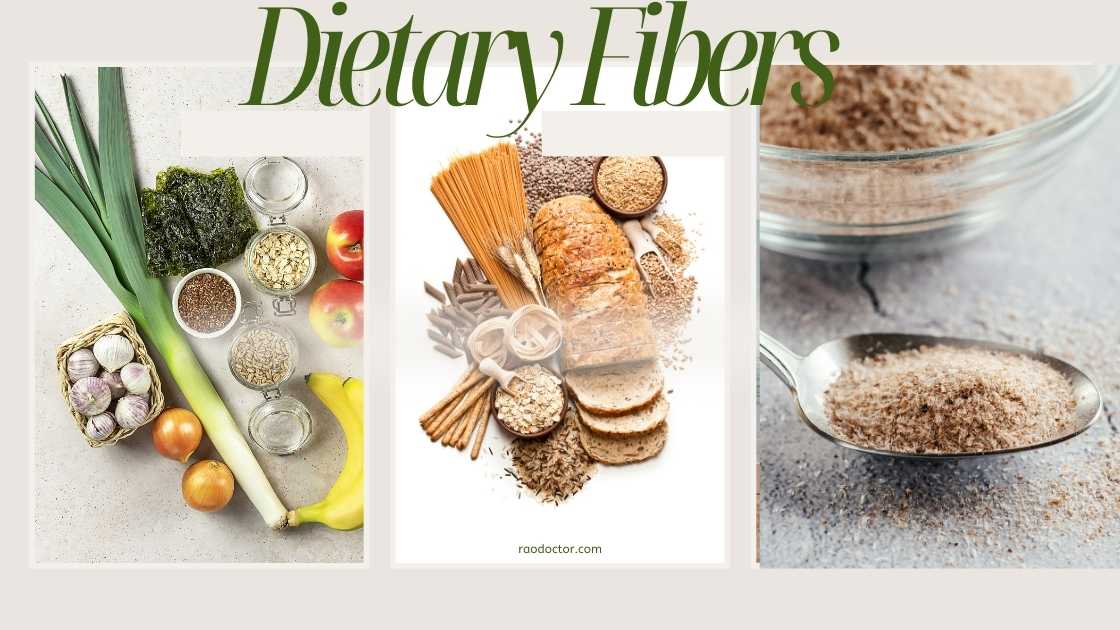What are dietary fibers?

What are Dietary Fibers
Dietary fibers are an essential component of a healthy diet. They are a type of complex carbohydrate that is not easily digested by our bodies.
Instead, they pass through our digestive system relatively intact, providing numerous health benefits. These benefits include lowering cholesterol levels, improving blood sugar control, and promoting regular bowel movements.
What are the different types of dietary fibers available for consumption and what are the benefits of using them?
There are a wide variety of fibers with different features and properties that help us in the digestive process in our intestines. Here are the varieties you can get-
Soluble fiber: This type of fiber dissolves in water and forms a gel-like substance.
Examples include oat bran, psyllium husk, beans, peas, lentils, fruits, and vegetables.
Features:
- Helps lower cholesterol levels
- Slows down the absorption of sugar, leading to better blood sugar control
- Increases feelings of fullness, aiding in weight management
Insoluble fiber: This type of fiber does not dissolve in water and passes through the digestive system largely intact.
Examples include wheat bran, whole grains, nuts, seeds, and some vegetables.
Features:
- Helps promote regular bowel movements
- May reduce the risk of colon cancer
- Helps prevent constipation and hemorrhoids
Resistant starch: This type of fiber resists digestion and behaves like soluble fiber.
Examples include cooked and cooled rice, potatoes, and legumes.
Features:
- Acts as a prebiotic, feeding the beneficial bacteria in the gut
- Helps improve insulin sensitivity
Pectin: A type of soluble fiber found in fruits. This type is used as stool hardener in case of diarrhea, especially in children.
Features:
- Forms a gel in the intestines, slowing down the passage of food and reducing appetite
- Helps regulate bowel movements
Beta-glucan: A type of soluble fiber found in oats and barley.
Features:
- Helps lower cholesterol levels
- Helps control blood sugar levels
- May boost the immune system
Cellulose: A type of insoluble fiber found in plant cell walls.
Features:
- Adds bulk to the diet, promoting regular bowel movements
- Helps prevent constipation and may reduce the risk of colon cancer.
Overall, consuming a variety of different types of dietary fibers can provide a range of health benefits, including improved digestion, better blood sugar control, and reduced risk of chronic diseases.
What are the different sources of Dietary fibers?
There are many sources of dietary fibers, including fruits, vegetables, nuts, seeds, and whole grains. Some of the best food sources of dietary fibers include berries, avocados, broccoli, lentils, almonds, chia seeds, and oats.
By incorporating more of these foods into your diet, you can increase your intake of dietary fibers and enjoy their many health benefits.
How to use Dietary fibers?
One easy way to incorporate more dietary fibers into your diet is to start by making small changes. For example, try switching from white bread to whole-grain bread or adding a handful of berries to your morning cereal.
You can also try swapping out high-fat snacks for fiber-rich options like fresh fruit or raw vegetables with hummus. Another great way to get more dietary fiber is to eat a variety of colorful fruits and vegetables each day.
How much fibers should we have in our daily diet?
The daily requirement of dietary fiber varies based on age and sex.
- According to the Institute of Medicine, the recommended daily intake of fiber for adults up to age 50 is 25 grams for women and 38 grams for men.
- For adults over the age of 50, the recommended daily intake decreases to 21 grams for women and 30 grams for men.
- Children also have different requirements, with toddlers needing around 19 grams per day and teenagers needing 26-38 grams per day.
- Pregnant and lactating women may require additional fiber, with recommendations ranging from 28-29 grams per day.
- It’s important to note that these are general recommendations and individual needs may vary based on factors such as activity level and overall health.
- Examples of high-fiber foods include fruits, vegetables, whole grains, legumes, and nuts and seeds.
It’s important to remember that increasing your intake of dietary fibers should be done gradually. Suddenly consuming large amounts of fiber can cause bloating, gas, and other digestive issues. To prevent this, start by adding small amounts of fiber-rich foods to your meals and gradually increasing the amount over time.
Additionally, be sure to drink plenty of water throughout the day to help your body process the fiber.
Useful resource- Dietary fiber: Essential for a healthy diet
Conclusion
In conclusion, incorporating more dietary fibers into your diet is a simple and effective way to improve your overall health.
By choosing fiber-rich foods like fruits, vegetables, nuts, seeds, and whole grains and making small changes to your daily diet, you can increase your fiber intake and enjoy the many health benefits that come with it.
Remember to start small and be patient with yourself as you work to establish healthy eating habits over time.

